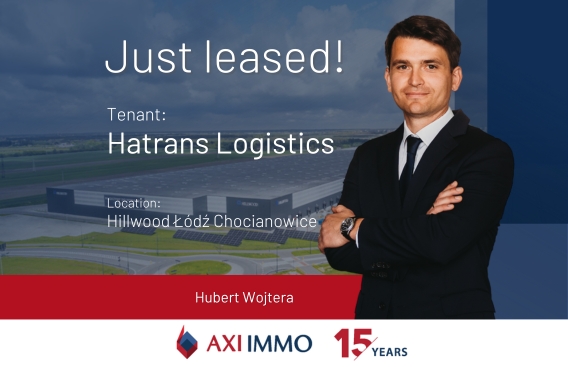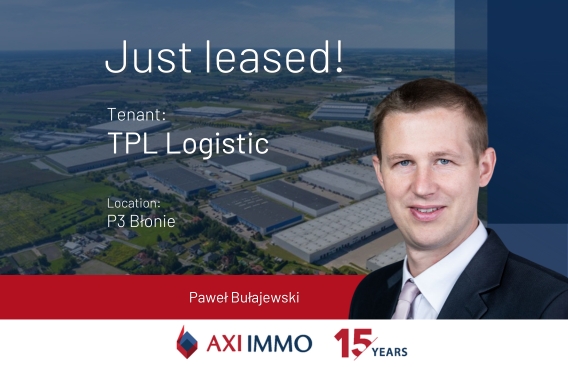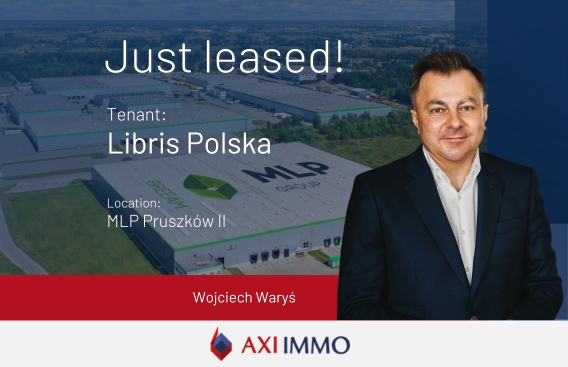Raport: E-commerce and logistics drive warehouse real estate development in Upper Silesia, Poland
Report - warehouse market in Upper Silesia at the end of Q2 2021 - from the beginning of Q3 20 to the end of Q2 / 21, 1.1 million sq m warehouse space was leased in Upper Silesia!

Upper Silesia is one of Poland’s largest and most important warehouse markets and a key distribution hub for Central and Eastern Europe. The region benefits from excellent and contunuously improving road infrastructure, an extensive rail network, the well-located airport in Pyrzowice and the fast-growing Katowice Special Economic Zone. For many years, Upper Silesia has been undergoing transformation from a typical mining monoculture into a modern industrial and technological cluster. Between Q3 2020 and the end of Q2 2021, 1.1m sq m of warehouse space was leased across the region, which is the second best result in Poland after Warsaw. Upper Silesia is successfully attracting new investments from a range of occupiers, including international firms seeking to shorten their supply chains in Europe by relocating production from Asia.
A record quarter on the Upper Silesian warehouse market
Total take-up in the Upper Silesian warehouse market reached 552,000 sq m in the first half of 2021 (+39.1% vs H1 2020). A total of 355,000 sq m was leased in Q2 2021, which marks the highest level in the history of the market. Moreover, from Q3 2020 to Q2 2021, the gross take-up amounted to 1.1m sq m, the second-highest result in Poland after Warsaw. Among the largest transactions closed in this period were three Panattoni deals involving three BTS schemes – 82,200 sq m for a global e-commerce player (Q2 2021) in Gorzyczki, 60,800 sq m for Action in Tychy (Q3 2020) and 50,290 sq m for Weber (Q2 2020) in Zabrze. In addition, a confidential tenant from the FMCG industry decided to extend lease with SEGRO LP Gliwice (45,000 sq m – Q3 2020). Moreover, supermarket chain Auchan decided to sign a new 53,700 sq m lease at the GLP Lędziny logistics centre.
Demand structure for warehouse properties in Upper Silesia
Over the past 18 months, retail (38%) and manufacturing (19%) were responsible for over 50% of gross demand in Upper Silesia, followed by e-commerce (16%), logistics (12%) and automotive (8%). Leasing activity by firms from the logistics and e-commerce sectors increased by 10% year-on-year. At the same time, the automotive industry, which plays a significant role in the Upper Silesian economy, struggled to cope with the disruptions associated with production outages. Currently, a significant part of the demand consists of transactions concluded by retail chains, e-commerce and accompanying packaging companies, as well as local and international logistics operators. The scale of third party logistics contracts involving servicing online shops is set to grow, as e-commerce requires up to three times more warehouse space than traditional retail.
Moreover, after a temporary lull in the automotive industry, electromobility is driving the sector forward, and forcing it to innovate. Poland has established itself as an important hub globally for the production of electric cars and batteries for electirc cars. In 2020, the sales of electric vehicles increased globally by 40%, despite the decline in traditional car sales. An example of investment in the sector in Silesia is the launch of production lines for electric and hybrid models of Jeep, Fiat and Alfa Romeo at FCA Tychy.
Upper Silesia, therefore, benefits from the strong development of the logistics sector driven by e-commerce and the growing and increasingly innovative automotive industry. In addition, demand is generated by retail chains, for which the large and populous Silesian agglomeration is an attractive consumer market. Moreover, due to its diversification, the scale of its internal market and its excellent location at the crossroads of European trade routes, it has attracted investment during the pandemic. The region is chosen for its well-qualified and accessible workforce as well as its industrial traditions. Further modern investments in warehouses are in the pipeline, including those involving chains of numerous sub-suppliers.
Upper Silesia also as a distribution hub for Central and Eastern Europe
Apart from its long-established position in Poland, Upper Silesia is also a key distribution hub for Central and Eastern Europe. The region’s geographic location is suitable for managing supply chains between Poland, Germany, the Czech Republic, Slovakia, and countries in southern Europe. The region also benefits from well-developed road infrastructure, including the key interchange at Sośnica, which provides a convenient connection between the A1 and A4 motorways, a high density of national and regional roads, including the Drogowa Trasa Średnicowa (DTŚ). Moreover, the most extensive railway network in Poland is located here. Finally, the region boasts an important Katowice Airport in Pyrzowice.
High level of new supply
Between January and June 2021, developers completed approx. 250,000 sq m of modern warehouse space, which took total warehouse stock in Upper Silesia to 3.8m sq m (+16% y/y), thus strengthening the region’s second position in Poland. The largest completed logistic parks in this period were 7R Beskid Park II with an area of 70,900 sq m (1 BTS building and two multi-tenant buildings), Panattoni BTS OTCF Czeladź (67,000 sq m) and Hillwood Piekary Śląskie (42,500 sq m). At the end of H1 2021, a total of 559,000 sq m was under construction (+43% y/y), marking the best result of all warehouse markets in Poland. Among the schemed in the pipeline for this year, the largest amount of space will be delivered by three Panattoni projects, i.e. Panattoni Park Ruda Śląska III (72,000 sq m), Panattoni BTS Action in Tychy (60,800 sq m) and Panattoni Bielsko-Biała IV (60,600 sq m). As at the end of June 2021, the vacancy rate stood at 8.7% and the share of space under construction on a speculative basis stood at 20% ( below the national average of 29%). After a periodic pandemic-related development slowdown and greater caution on the part of developers, we can expect more projects to break ground in this market in due course. Investors are interested in strengthening their position in established sub-regions such as Sosnowiec, Gliwice, Tychy and Bielsko-Biała, but also in entering smaller emerging markets such as Częstochowa or Żory.
More and more last mile and SBU warehouses
Stable and robust demand generated both by logistics and e-commerce has triggered as supply response. Given limited availability of quality land in key locations, developers are turning to brownfield projects, which require higher expenditures and know-how. An example can be the activity of Panattoni and Hillwood, who have completed many successful brownfield projects in the region. Moreover, Upper Silesia is diversified in terms of available industrial real estate formats. It is dominated by densely built-up urban areas, with no clear distinction between urban and suburban land. Projects are diverse and match occupiers’ requirements, resulting in an increasing number of so-called last mile and SBU schemes. Big international players, such as Panattoni, Segro, Logicor, GLP or Prologis, and national entities, such as 7R, or even regional developers, such as DL Invest or BIK, are marking their presence in the region.
Warehouses in Upper Silesia as prime products
High diversification, market stability and ease of exit due to high investment liquidity make projects in Silesia sought-after elements of international investors’ portfolios, often classified as prime products. The activity of investors in the first half of 2021 may serve as an example. REINO Capital & IO Asset Management, on behalf of Grosvenor Group, became the new owners of five properties totalling 165,600 sq m located in Upper Silesia, Poznań and Łódź, acquiring the rights to the portfolio previously owned by AEW. In the city logistics segment, pan-European investment entity M7 Real Estate acquired two parks from 7R, i.e. 7R City Flex Sosnowiec and 7R Siemianowice Śląskie, with a total area of 22,500 sq m.
Author: Anna Głowacz, Head of Industrial, AXI IMMO
ABOUT AXI IMMO
AXI IMMO offers commercial real estate advisory services in the areas of leasing and management of office and industrial space as well as acquisition and disposal of real estate assets and development land. The company also offers B2B and B2C supply chain management services. AXI IMMO’s biggest advantage is combining international standards of service with a thorough knowledge of the local market. The company received the award for the Best Local Agency in 2012-2019 and the Best Team for the industrial sector in 2016-2017 in the prestigious CiJ Awards organised by the CEE CiJ Journal magazine.
This article appeared in issue 125 of Eurologistics (August-September 2021).
Recent articles

25 July 2024
Trako Team is a new tenant at CTPark Warsaw North, advises AXI IMMO
Trako Team Rafał Kopański has leased about 10,000 sqm. of modern warehouse space in CTPark Warsaw North near Warsaw in the Czosnów commune. The Polish brand from the TSL sector will launch its first warehouse in the country, where it will store, among others, textiles, packaging and household chemicals. In the coming years, Trako Team […]

12 July 2024
AXI IMMO advises Hatrans Logistics on lease of 5,000 sq m at Hillwood Łódź Chocianowice
AXI IMMO exclusive agent for Hatrans Logistics in the selection of modern logistics space in the southwest of Łódź

11 July 2024
Polish company TPL Logistic sets its sights on P3 Błonie park near Warsaw, advised by AXI IMMO
AXI IMMO advised TPL Logistic on signing a lease at P3 Park Błonie.

26 June 2024
Over 5000 sqm for Libris Polska at MLP Pruszków II, Poland, advises AXI IMMO agency
AXI IMMO advises Libris Polska on the lease of modern warehouse space